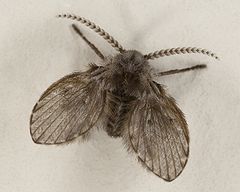This must be the most frequently asked question about flies, and although it is not really my field, I feel compelled to comment on it. After all, as much as we appreciate and admire our two-winged friends, they can be annoying to downright deadly at times. So, for those suffering from from an affliction of Diptera, here is a tentative key to fly problems I have faced.
NOTE 1: An “affliction” is more than the odd fly or two. Most fly problems are avoided by the commonsense practices of using screens on windows and keeping trash outdoors.
NOTE 2: My advice is for entertainment purposes only; I do not pretend to be an expert on fly control and I cannot respond for requests to help with fly problems. Please contact a licensed pest control professional.
Key to Fly Problems:
1. The fly problem is indoors… go to lead 2
-. The fly problem is outdoors… will be in part 2 (next blog)
2. Big grey, grey and black striped flies, or metallic blue or green flies suddenly appear in large numbers, usually attracted to the daylight at windows… Answer: 1) Something has died in or under your home (frequently a rat). Look for and dispose of carcasses. Be aware that this problem will go away in a week or two as the flies go through the food. 2) If this occurs in early spring or on warm winter days (where winters are cold), it is more likely these are overwintering cluster flies that have been “awakened” by warm temperatures. You need to seal around window casings (the usual entry point) to prevent them from entering the house.
– Smaller, less chunky flies… 3
3. Hairy, mothlike flies with broad but pointed wings (see photo below)… Answer: You have flies called moth or drain flies. Their larvae live in the accumulated sludge in your drains. Clean the drains and they should go away.
– Flies not so hairy and wings not pointed… 4

4. Small yellowish flies slowly hovering hovering over fruit, wine glasses, or open trash… Answer: Pomace or vinegar flies (genus Drosophila), also commonly known as “fruit flies”. Attracted to odors of decay, especially fermentation. Get rid of the decaying material, clean up trash, and the flies will quickly go away.
– Flies not yellow, or if yellow, run quickly and do not slowly hover… 5
5. A group of flies forming a swarm (a group of flying individuals), gently zig-zagging, always in flight in doorways, alcoves, or the center of a room… Answer: Lesser house fly males have come in through an open door or window. They are harmless and will disappear in a few hours. Window and door screens will prevent this.
– Not forming a swarm indoors… 6
6. Black-winged, tiny gnats that seem to be attracted to lights, or strangely, to the pages of a book you are reading at night. They seem to gently fly or “dance” against the pages or whatever surface. Associated with house plants… Answer: Dark-winged fungus gnats are breeding in the soil of your house plants. They are harmless, but potentially annoying. If they become unbearable, try watering the plants less, or getting rid of the most affected plant.
– Flies not dark winged, not a gentle fliers, not associated with plants… 8
8. Flies usually run, not fly, in a distinctive “stop-go” pattern. When they fly, the flight is direct, not slowly hovering. Color various, but often with yellow… Answer: Phorid flies are in your house. Either something has died in the walls, where the bigger blow flies cannot get to it, you have a sewage leak under your house, or some other situation is amiss. Call in the professionals if they are overwhelming.
– Anything that gets to here is in the category of less common “pests” that need to be diagnosed on an individual basis. Different flies affect the indoors in a variety of ways in other parts of the world. I would be happy to read any accounts that differ from what I have written here.
next blog: outdoor fly pests


 A gaudy calliphorid from Australia: a runner-up to the world’s most beautiful fly
A gaudy calliphorid from Australia: a runner-up to the world’s most beautiful fly














